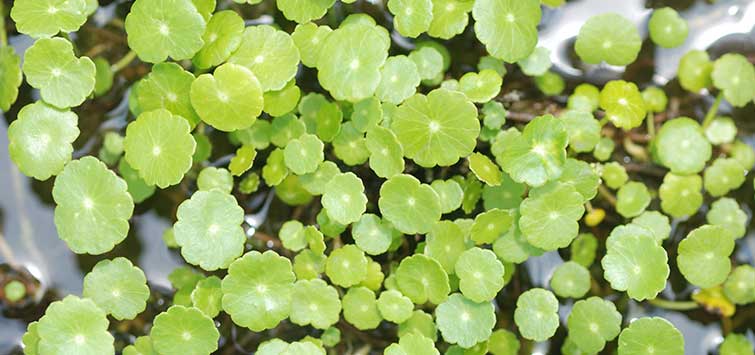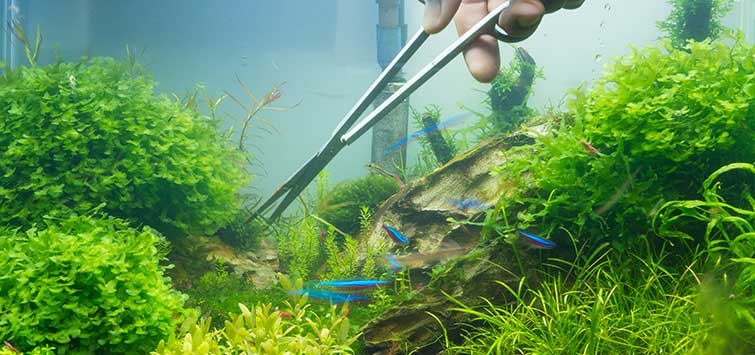The Planted Tank: Floating Plants in the Aquarium
The Planted Tank: Floating Plants in the Aquarium
Author: Rhonda Wilson
The top of the water and the surface above it is the best place for light and gas exchange. Most plants, even when rooted in the substrate, try to send their leaves and stem close to the surface to take advantage of this prime aquatic real estate. Some plants have evolved to spend their entire lives floating in the water; several have even given up their roots, finding them to be unnecessary in this environment.
Floating plants in the aquarium can be useful, particularly for breeding purposes and for providing hiding places for fry. They can also be used to shade parts of the aquarium if needed, and they can be quite useful if you want plants in a bare-bottom tank. Several floating plants are commonly found for sale for both aquariums and ponds, with varying degrees of ease of growth and usefulness for the aquarium.
AZOLLA
Azolla is a floating fern. There are about six living species in the genus, though more than 25 have been recognized in fossils. Azolla is mostly used in ponds and can be difficult to grow in the aquarium. Low water movement, nutrient-rich waters, and high lighting are recommended for their growth. Azolla caroliniana and A. filiculoides are native to some parts of North America. A. pinnata is considered an invasive plant on the Federal Noxious Weed List. Many Azolla have become noxious weeds in different countries across the world.
Unlike many plants on the Federal Noxious Weed List, Azolla are actually quite useful. They have an interesting symbiotic relationship with blue-green algae Anabaena azollae; because of this relationship, and the nitrogen-fixing ability of the blue-green algae, Azolla are used as a green fertilizer. They are also supposed to be nutritious with a high level of protein and are used for livestock and even eaten by people.
CERATOPHYLLUM
Hornwort Ceratophyllum spp. is a very common feathery leaved aquarium plant that will grow well in many aquariums. It also stands up to many fish that may have tendencies to include salad in their diets.
Hornwort is unique in that it will never develop roots. You can put the plant in bunches in the back of your tank, and it can look nice that way. Keep in mind that roots won’t ever form, and if you place any part of hornwort under the substrate, that portion will die.
Hornwort can grow under both low and high light levels. In lower light it will be thinner and a brighter green in color. In higher light the plant gets bushier and can develop red tints, particularly in the stem. In fact, hornwort is usually very easy to grow in the aquarium and pretty much anywhere else. Though a native of North America, this plant has been introduced in many parts of the world where it’s become a problematic weed.
Ceratophyllaceae is a separate family, and its relationship to other plants is still undetermined. They seem to be confusing plants for botanists, and the number of different species isn’t certain either. Earlier sources argued that there are one or two species, while newer sources list six or seven, but over 30 have been described, albeit with many of those almost certainly being the same highly variable plants.
EICHHORNIA CRASSIPES
Water hyacinth Eichhornia crassipes is a beautiful flowering plant originally from South America and used mainly in ponds. E. crassipes is listed as a noxious weed in many states and countries, and it’s one of the most problematic of the invasive weeds in the world, able to fully cover a lake or pond from shore to shore.
Water hyacinth isn’t a practical plant for most aquariums. The plant can get quite tall if it does well, but it usually doesn’t when inside. Considering its invasiveness, possible illegality in many states, and the fact that it isn’t a practical plant in most aquariums, I would not suggest using this plant.
FAMILY LENNACEAE
The duckweeds and their close relatives are some of the most well-known aquatic plants, seeming to occur just about everywhere there’s water. Duckweeds can often become a pest in the home aquarium, but they can also be useful, and they have been used in aquariums since the beginning of the hobby.
The duckweed plants are all pretty small, but they come in different small sizes. The smallest are the Wolffia. These tiny plants are the smallest known flowering plants in the world, and their leaves are only 1 to 1½ millimeters. Wolffia are sometimes called water meal because of their small size. Unlike the larger duckweeds, Wolffia don’t have roots. This is a neat plant to have in the aquarium, but it’s very hard to keep because most fish seem to think they are on the dinner menu.
The most common duckweeds are the middle-sized ones of the genus Lemna, which has more than a dozen species. Duckweed is usually very easy to grow in the aquarium—though I have had tanks where it just didn’t want to grow (some sources indicate this can mean there are nutritional deficiencies in the water).
Duckweed can look different in different aquariums. In some tanks it will have very long roots hanging down, while in others the roots will stay short because they are nibbled on by the fish. Sometimes duckweed may drop its roots, making a mess of the bottom of the tank. Some aquarists use string or other barriers at the top of the tank to try to keep duckweed roped into a specific area. If you don’t have a fish that eats it, the next best way to keep duckweed under control is to remove the excess plants by hand.
Larger duckweeds include Spirodela and Landoltia. These are similar to the Lemna. Often in the wild, and sometimes in the aquarium, you will end up with several different types of duckweed growing in the same place.
LIMNOBIUM
Forgbit Limnobium spp. is another plant that is common for ponds but can grow in the aquarium. Two species that may be available are Limnobium laevigatum, from Central and South America, and L. spongia from North America. The plants are very similar in appearance; they both look like very large duckweeds, but they aren’t closely related. In fact they are from the family Hydrocharitaceae and are related to such diverse-looking plants as Blyxa, Najas, Elodea, and Vallisneria.
Frogbit will need good lighting to grow in the aquarium. If it likes your tank it can grow quickly and will have to be regularly thinned. Daughter plants grow on stolons to the sides of the plants. Remember these plants can have very long roots that will easily reach to the substrate in most aquariums. Also keep in mind that it will be shady underneath the frogbit, so be sure to plan accordingly for where it will sit on the surface of the aquarium.
PISTIA STRATIOTES
Water lettuce Pistia stratiotes is another plant used often in ponds. As the common name implies, this plant looks like a head of lettuce sitting on top of the water with roots hanging below. Like water hyacinth, you have to keep in mind the height of the plant out of the water when considering it for the aquarium; it would probably work better in an open tank than one with a cover. This is not an easy plant to grow in the aquarium, and it needs a great deal of light.
There is some debate about whether water lettuce is a native plant in the United States or not, but either way it has been here for a long time (the first recorded observation was in 1765). It has caused problems as an invasive weed in some places and is listed as such in some states.
RICCIA
Riccia fluitans is a liverwort that’s been getting a lot of attention lately as a ground cover. When tied to rocks it does make an attractive lawn plant in the aquarium, but for years it’s been kept floating, which is the way it grows naturally. In the past this plant was commonly called crystalwort, and it is referenced in aquarium literature from as early as the late 1800s. It’s a particularly useful plant in the breeding of some fish, as the dense mats can hide tiny fry much better than most plants, even other floating ones.
SALVINIA
Salvinia is a floating fern most often used in ponds. It is interesting in that the “roots” seen floating below the plant is actually a modified leaf. There are currently 10 species of Salvinia considered, and none of them are native to the United States (but they are in the country now). Four of the species are on the federal noxious weed list, and they are also invasive in many other countries. Salvinia will sometimes grow in an aquarium under the right conditions, but considering its status I would advise against growing it at this point.
UTRICULARIA
Bladderworts are very interesting carnivorous plants, and there are several of them that you can keep in the aquarium. There are over 200 species of bladderworts worldwide, living both in the water and in moist environments. With their fine feathery leaves bladderworts can look like several other aquatic plants, but their tiny bladders set them apart. These small bladders capture tiny insects and crustaceans, sometimes even very tiny fish fry, depending on the type and size of the plant.
I’ve found bladderworts to be somewhat temperamental in the aquarium. Some are not very attractive and look more like hair algae with a few very tiny bladders thrown in. These types seem to grow about as well as hair algae in the aquarium and are generally a nuisance. Other more attractive bladderworts can be somewhat temperamental as well, growing well for some time and then deciding to fade away, popping up again several months later. I’ve noticed they don’t play the fading away trick in tanks with added CO2. When I’ve put the bladderworts in tanks with additional CO2 their leaf growth isn’t as thick.
Bladderworts don’t usually flower in the aquarium, but if they do the small and lovely flowers grow above the water. Depending on the species the flowers can range from yellow to violet.
A LOT TO OFFER
There’s a large selection of floating plants that can be used in the aquarium for a variety of purposes. Sometimes these plants can be overlooked when deciding what to put in your tank, but they have a lot to offer. Floating plants can be useful for utilitarian purposes like breeding your fish or using plants in a bare-bottom tank. Some of them have very fast growth and can be useful in helping to clean up your tank.
Floating plants can also bring the beauty and interest of long-hanging roots to your pristinely aquascaped planted tank. And floating plants can add something uniquely unusual for the collector, like the carnivorous bladderwort. There are many more floating plant species and many more uses for them than I could possibly cover in one column, but perhaps this brief review will encourage you to try some of them in your aquarium.

.png?h=595&iar=0&w=2781&hash=5FD5E69473BCC22199FBFA2FB71B6033)



